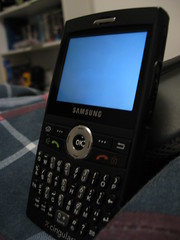 Image via Wikipedia
Image via Wikipedia
Every so often, as technology changes, people like to make predictions about what the future holds for us.
I love these visions of the future from
semantic web folks:
Web 2.0 – Web 3.0 – Web 4.0? one8nine UnConference Blog: "
I’m booked on a flight from Toledo to Seattle. It’s cancelled. My phone knows that I’m on the flight, knows that it’s cancelled and knows what flights I should consider instead. It uses semantic data but it also has permission to interrupt me and tell me about it. Much more important, it knows what my colleagues are doing in response to this event and tells me. ‘Follow me’ gets a lot easier."
There are so many things wrong with this scenario! What if the phone is wrong? What if you are not on a flight and it only thinks you are on a flight and then buys you a one-way plane ticket to Damascus by mistake? Now your boss wants to know why you are charging plane tickets to Syria and Homeland Security has put you on a watch list because you are buying one way tickets to Syria and you forgot to update your passport. Why? Because the same glitch that bought the ticket forgot to send you an email reminder that your passport had expired. The semantic web is smart enough to correct those errors, but after a long talk with your
HAL9000 smart phone, they said to hell with it. Why should we take care of someone not smart enough to secure his bluetooth connections and needs an email reminder to breathe? I don't want to be interrupted by my phone. What would it say if I wanted to change service?
Here is another great scenario for the future:
"
As a project manager, my computer knows my flow chart and dependencies for what we’re working on. And so does the computer of every person on the project, inside my team and out. As soon as something goes wrong (or right) the entire chart updates."
And what happens when our phones realize we are in trouble financially? They get concerned. We could be jeopardizing the mission. What would happen to them if we go for a cheaper plan? They suck data from our
RFID chips and credit cards, make a run on the company, and buy us out.
It is really difficult to predict what the future holds for us in technology because we can't really predict the necessary conditions for change. If someone could have predicted what the economy was doing five years ago, then someone might, for instance, have had some idea about how innovation would happen in education.

 Image via Wikipedia
Image via Wikipedia![Reblog this post [with Zemanta]](http://img.zemanta.com/reblog_e.png?x-id=d836811f-1603-4c5a-8b57-6f390abf45ab)


![Reblog this post [with Zemanta]](http://img.zemanta.com/reblog_e.png?x-id=6b79a636-0a6a-4890-bd02-c5d0dd5a6b59)

![Reblog this post [with Zemanta]](http://img.zemanta.com/reblog_e.png?x-id=09a387d0-6902-44cf-b297-da308f33c249)

![Reblog this post [with Zemanta]](http://img.zemanta.com/reblog_e.png?x-id=a5029ee8-aa1f-40a5-9164-cbbb8d13d414)